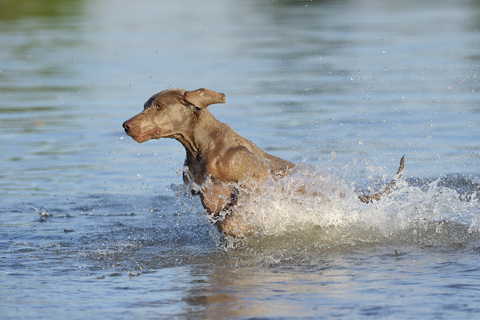Gundog breeds: Why buy a Weimaraner?

Whatever you may think of the Weimaraner (pronounced vy-maraner) there is no denying it is a noble looking gundog. There is only one official colour, silver grey, which makes it instantly recognisable. It was indeed the nobles of Saxe-Weimar in eastern Germany who during the 1800s were responsible for the breed we know today, although early origins date back as early as the 13th century.
So what makes the Weimaraner so unique and special that once owners have fallen under their spell they often remain a devotee for life? The answer, I believe, lies with their character formed from their history. Grey hunting dogs, ‘long eared and of noble aspect’ were depicted on tapestries and paintings in museums and castles throughout Europe in the 15th century and gave rise to their nickname ‘the grey ghost’.
 This handsome breed originates in east Germany where it was hunted in packs for stags and wild boar.
This handsome breed originates in east Germany where it was hunted in packs for stags and wild boar.
The Grand Dukes of Weimar hunted them in packs for large game such as stags and wild boar. The breed was highly valued and breeding was strictly regulated, which still applies in Germany today. As large game hunting declined, the Weimaraner was used on smaller quarry and became the Hunt Point Retriever (HPR) breed which is recognised on shoots today.
The first Weimaraners were introduced into Great Britain in March 1952 by Major Petty, who had seen the breed working whilst serving in Germany. A year later, the major organised the inaugural meeting of the Weimaraner Club of Great Britain at Crufts, on gundog day, in February 1953.
This year, the club is celebrating its Diamond Jubilee, 60 years which have seen the Weimaraner become one of the most popular of the HPR breeds.
A misunderstood concept
HPRs are often misunderstood and regarded with suspicion. Correctly trained, they should do exactly as their classification implies. They hunt up game and, when located, hold a steady point until sent in to flush and finally retrieve to hand, from water and any terrain.
The breed standard includes the descriptions: “Medium sized, grey with light eyes. Presents a picture of power, stamina and balance. Fearless, friendly, protective, obedient and alert. Hunting ability of paramount concern.”
These were the qualities the early Germanic Foresters recognised and they used the Weimaraner as an efficient hunter of game for food, a tracker of wounded animals and as a companion and protector at home, creating a complex mix of boldness, natural ability and an affinity with their owner.
Weimaraners lived as part of the family and were rarely kennelled, thriving on human company. This is a strong trait still in evidence today. The Weimaraner is very much a one-person dog and mutual respect must be built between dog and handler to achieve a working partnership, which is why you never see trained Weimaraners for sale. That is not to say they are untrainable.
A unique breed
Training such diversification is not easy and it requires patience and perseverance to make a Weimaraner up to the standard of control required in the shooting field, whether it is on the grouse moors, as a shooting companion, in the beating line, picking-up or used with birds of prey.
Socialisation and training are essential from an early age as left unchecked, the Weimaraner will rule the roost. That cute roly-poly silver bundle born with blue eyes soon changes into a deceptive powerhouse with independent thinking.
The majority of Weimaraners will be found in pet homes and the show ring, but there are stalwarts of the breed promoting the working side to successfully compete, at all levels, in field trials, agility and working trials. All of which utilise their natural talents and athleticism.
Strong ancestry
Working trials have nothing to do with field trials as no game is involved, but they comprise a set of exercises to test obedience, agility and nosework. Their link to bloodhound ancestry gives the Weimaraner an exceptional nose and they excel at tracking, on blood, game or human scent.
Training for working trial exercises should not affect the dog’s ability to work as a gundog, as they are intelligent enough to know what discipline is required with the relevant commands.
This is not a breed for the faint hearted or anyone who wants quick results. Highly intelligent and requiring equal mental and physical exercise, the Weimaraner is a strange mix of sensitivity, boldness and stubbornness. And those who think dogs do not reason have never lived with a Weimaraner. This is a unique breed and deserves a unique owner who respects and understands the origins of the versatile Weimaraner.








